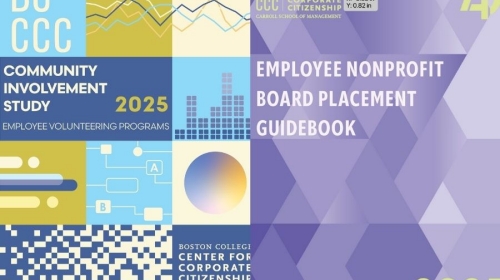WEBINAR: This webinar explores how to measure and communicate your organization's social impact with proven frameworks and strategies that matter to stakeholders.
Employee Relief Funds: Supporting your Workforce Through Hardship

This week, the Senate passed a $2 trillion dollar stimulus deal that aims to ease the economic ramifications of COVID-19. This stimulus package—which offers $250 billion in direct payments to individuals and families, $350 billion in small business loans, $250 billion in unemployment insurance benefits, and $500 billion in loans for distressed companies—would help those struggling to support themselves and their families.
To help support their employees further, companies are stepping up to provide additional aid—though paid leave options, remote working, and/or engaging volunteer options. Some companies, such as Center members Fifth Third Bank, Microsoft, Major League Baseball, and U.S. Bank are offering additional payment to those who continue to work on-site, or are unable to work remotely. Others, such as Wells Fargo and EY are reimbursing hourly workers for family-care costs.
Companies are also turning to employee relief funds (ERFs), sometimes called employee assistance funds or employee crisis funds. These programs help employees cope with financial problems that render them unable to provide for basic necessities in their personal lives.
Many are leveraging their existing ERFs to support workers affected by COVID-19. For example, Blue Cross Blue Shield of Louisiana is matching all employee donations to its Employees 1st fund, while Lowe’s is committing a portion the $25 million it’s donating to support those affected by the virus to the Lowe’s Employee Relief Fund. Iron Mountain and Cox Enterprises are also leveraging their established ERGs to help employees in need.
As this pandemic continues, employee needs are becoming increasingly complex, and more CSR professionals than ever are reaching out to us for advice on setting up their own employee relief funds. We’ve compiled the below to help you think though some of the basics of employee-sponsored charities, and have outlined some of the differences between the available charity types. Members should also check out our Disaster Relief Issue Brief for more information. It is important to remember that those without charitable employee relief funds are still able to provide direct assistance to disaster victims and some companies may opt to do that as a part of operations. For those that want to direct funds through a charitable entity for tax or other reasons, here are some things to be aware of.
PLEASE NOTE: The below is provided as informational background and does not constitute legal advice. Those seeking to establish an Employee Relief Fund should consult counsel to ensure compliance with all federal, state, and local regulations, and should ensure that it is compliant with all IRS guidance, including but not limited to Publication 3833, Disaster Relief, Providing Assistance Through Charitable Organizations.
- The basics of employer-sponsored charities The IRS requires that all charitable organizations—even those who provide disaster relief—demonstrate that they serve public rather than private interests. As such, an employee relief fund run as (or as part of) a charitable organization such as a foundation must show that that payments are not for the employer’s benefit by:
- Serving a sufficiently broad charitable class, such as all current and former employees.
- Selecting recipients based on an objective determination of need or distress.
- Creating an independent selection committee (i.e., a majority of the committee consists of persons not in a position to exercise substantial influence over the employer’s affairs), or some similar procedures designed to ensure that any benefit to the employer is incidental.
- There is more than one way to distribute funds. To establish an ERF as tax-advantaged plan, the employer must set up a nonprofit entity that receives contributions and disburses grants (not loans) to employees. The types of benefits a charitable organization can provide through an ERF depend on whether the employer-sponsored organization is a public charity, a private foundation, or a donor-advised fund.
- Public charity—Because public charities typically receive broad financial support from the general public, their operations are generally more transparent and are subject to greater public scrutiny. Accordingly, public charities may provide a broader range of assistance to employees than can be provided by donor-advised funds or private foundations. An employer can establish an employer-sponsored public charity to provide assistance programs that respond to any type of disaster or employee emergency hardship situations, as long as the related employer does not exercise excessive control over the organization
- Private foundation—Employer-sponsored private foundations may provide assistance to employees or family members affected by a qualified disaster, as defined in section 139 of the IRS Code, as long as certain safeguards are in place to ensure that such assistance is serving charitable purposes, rather than the business purposes of the employer. Employer-sponsored private foundations can only make payments to employees or their family members affected by qualified disasters, not in non-qualified disasters or in emergency hardship situations. Also, while private foundations allow for gifts from the public and from officers of the company, company vendors, and employees, those that make significant gifts may become a “substantial contributor” and therefore a “Disqualified Person”.
- Donor-advised fund—Donor-advised funds established by other charitable foundations such as your local community foundation can make grants to 501(c)(3) public charities and, under certain conditions, to other organizations for charitable purposes, but cannot make grants to individual persons. However, there is an exception for certain employer-related funds or accounts established to benefit employees and their family members who are victims of a qualified disaster.
Regardless of the type, employee relief funds offer companies a valuable mechanism to support employees through hardship. In addition, sometimes an employer may provide assistance through a non-exempt fund established to receive contributions from the company as well as employees.
Whichever method you choose, we’ll be here to help. Please take advantage of Resource(ful), where we’re gathering new and existing resources most relevant to these times, reach out to your peers directly through our Online Member Community, and take advantage of our Knowledge Request service to get guidance tailored to your unique needs.
Related Content
RESEARCH BRIEF - Researchers investigated how ESG activities help or hurt financial performance, using nine years of data from over 1,200 global companies.
RESEARCH BRIEF - Researchers analyzed 4 US energy exchange-traded funds (ETFs) over 15 years, including 2 dirty energy funds tracking fossil fuel companies and 2 clean energy funds tracking renewable energy companies.
RESEARCH BRIEF - Researchers conducted a survey, which measured perceptions of CSR and ethical leadership within the manufacturing and service industries.
WEBINAR: This webinar explores how corporate giving will be reshaped by the One Big Beautiful Bill. Hear directly from corporate citizenship leaders as they share innovative, real-world strategies that deliver impact for communities and results for business.
This study explores shifting trends in employee volunteering, corporate giving, and other means of corporate community involvement.
This guidebook offers insights on placing employees in nonprofit board service roles.
This study explores shifting trends in employee volunteering, corporate giving, and other means of corporate community involvement.








